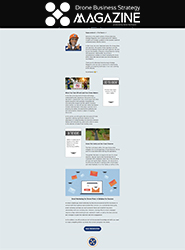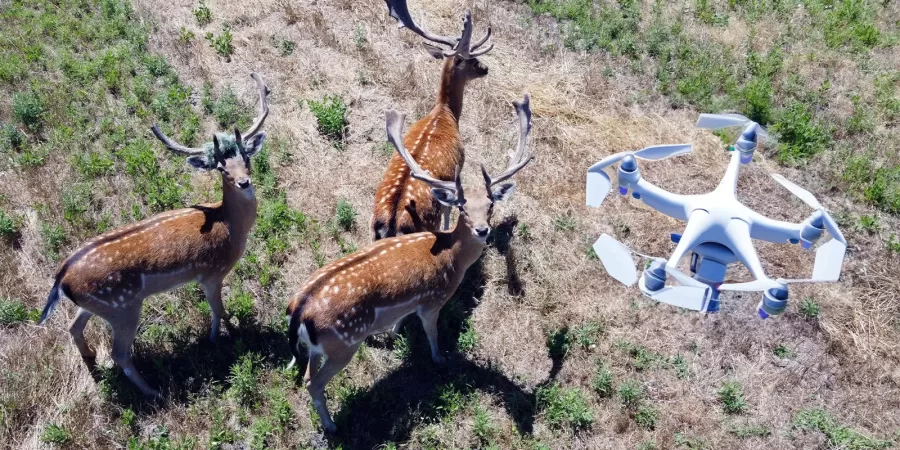Drone technology has revolutionized various industries, providing incredible opportunities for aerial photography, exploration, and research. However, when operating drones in areas where wildlife resides, it is essential for drone pilots to exercise awareness and responsibility. Understanding and respecting the natural habitats and behaviors of animals is crucial to minimize disturbance and potential harm.
In this article, we will delve into the significance of drone pilot awareness in wildlife areas and provide practical guidelines for responsible drone operation.
Wildlife Disturbance
Drones have the potential to disrupt and distress wildlife when flown too closely or at low altitudes. Such disturbances can lead to animals perceiving drones as threats, resulting in negative consequences like fleeing, abandoning nests or young, and disrupting feeding patterns. As responsible drone pilots, it is our duty to prioritize the welfare of wildlife and minimize our impact.
To strike a balance between enjoying the benefits of aerial photography and exploration while respecting the natural world, drone pilots must be aware of their surroundings and considerate of wildlife habitats and behaviors. This awareness allows us to prevent disturbance, show respect for their habitats, and contribute to the preservation of biodiversity.
Practicing responsible drone operation involves adhering to guidelines that minimize disruption to wildlife. During sensitive periods such as nesting or breeding seasons, it is crucial to avoid these areas entirely. Additionally, maintaining a safe distance and flying at higher altitudes can help minimize disturbance. By recognizing signs of stress or behavioral changes in wildlife, we can adjust our flight plans accordingly, prioritizing their well-being over capturing specific images or footage.
By embracing the incredible capabilities of drones and operating them responsibly, we foster a harmonious coexistence with wildlife and contribute to the long-term conservation of their habitats. Our awareness of environmental responsibilities enables us to protect the natural world for present and future generations, ensuring a sustainable and respectful relationship between humans and wildlife. As responsible drone pilots, it is our duty to minimize our impact and prioritize the welfare of animals.
Nesting and Breeding Season
During specific times of the year, many wildlife species enter nesting or breeding seasons that are crucial for their survival and population growth. These periods are particularly sensitive as animals engage in vital activities like nest-building, egg incubation, and rearing their young. Unfortunately, flying drones near these nesting sites or breeding grounds can have devastating consequences, including the abandonment of nests, destruction of eggs, or separation of parents and offspring.
To ensure the continued success and reproductive health of wildlife populations, it is paramount to avoid these areas during their sensitive periods. By respecting their habitats and refraining from interference, we make significant contributions to the preservation of biodiversity. By keeping a respectful distance from nesting or breeding grounds, drone pilots allow animals to carry out their essential tasks undisturbed, guaranteeing the survival of their species and maintaining the ecological equilibrium within their habitats.
By adhering to the principle of avoidance and acknowledging the importance of nesting and breeding seasons, drone pilots actively play a role in conserving wildlife populations. This approach showcases a deep commitment to safeguarding vulnerable stages of their life cycles and promoting the long-term well-being of the natural world.
By respecting the needs of wildlife during these critical periods, we uphold the delicate balance of our ecosystems and contribute to the overall health and resilience of our planet.
Behavioral Changes
The presence of drones can have a significant impact on the behavior of animals, often leading to abnormal responses. Animals may become agitated, showing signs of stress or anxiety, and they may alter their natural patterns of movement. These behavioral changes can disrupt crucial activities such as foraging, migration, or social interactions within their communities.
It is the responsibility of drone pilots to remain aware of these potential effects and take measures to minimize their impact on wildlife. By maintaining a deep understanding of wildlife behavior, drone pilots can adjust their flight plans and operations to minimize disturbance. This allows animals to behave naturally, undisturbed by the presence of drones, and fosters a harmonious coexistence between humans and wildlife.
Awareness of wildlife behavior is key to promoting responsible drone operation. By recognizing the signs of stress or agitation in animals, pilots can make informed decisions to minimize their presence or maintain a safe distance. This proactive approach ensures that drones do not disrupt important activities vital for the well-being and survival of wildlife populations.
Creating an environment where animals can behave naturally despite the presence of drones is crucial for their overall welfare and conservation. By prioritizing wildlife welfare and minimizing disturbance, drone pilots contribute to the preservation of biodiversity and enable both humans and wildlife to thrive in their respective habitats.
A harmonious coexistence is achieved when we actively respect and adapt our actions to minimize the impact of drone operations on wildlife behavior.
Physical Hazards
Operating drones in wildlife areas comes with inherent physical hazards due to the diverse terrains and vegetation present. Pilots must maintain constant awareness of their surroundings to avoid collisions with trees, rocks, or other obstacles. Such collisions not only endanger the drone itself but also pose a threat to wildlife if the drone were to fall or crash into their habitats. Responsible drone operation requires cautious navigation and prioritizing the safety of both the aircraft and the natural environment.
When flying drones in wildlife areas, pilots must recognize the potential physical hazards that exist. These areas often consist of varied landscapes, including trees, rocks, and other obstacles. As a result, it is crucial for drone pilots to remain vigilant and attentive to their surroundings in order to prevent collisions.
Collisions with trees, rocks, or other objects not only jeopardize the safety of the drone but also pose risks to wildlife. A drone falling or crashing into animal habitats could endanger their lives and disrupt their ecosystems. Consequently, responsible drone operation necessitates careful navigation and a commitment to safeguarding both the drone and the natural environment.
By maintaining awareness of the physical hazards and taking appropriate precautions, drone pilots can ensure the safety of their aircraft while minimizing risks to wildlife. This entails maintaining a safe distance from potential obstacles, meticulously planning flight routes, and being prepared to respond to unforeseen circumstances.
Responsible drone operation in wildlife areas necessitates striking a delicate balance between capturing captivating visuals and upholding the integrity of the natural environment. By prioritizing safety and exercising caution, drone pilots make valuable contributions to the preservation of wildlife habitats while minimizing any potential harm to both the drone and the animals residing in these areas.
Legal and Ethical Considerations
Operating drones in areas where wildlife resides requires a thorough understanding of the legal and ethical considerations surrounding wildlife protection. Governments around the world have established laws and regulations aimed at safeguarding wildlife and their habitats. Violating these regulations, such as flying drones in prohibited areas or disturbing wildlife, can have severe consequences, including fines, legal penalties, and the potential loss of drone-flying privileges.
As responsible drone pilots, it is our duty to familiarize ourselves with and adhere to these laws to ensure the well-being of both wildlife and the environment. This entails understanding the restricted areas where drone flights are prohibited and following specific guidelines to prevent disturbances to wildlife. By operating within the confines of the law, we actively contribute to the preservation of delicate ecosystems.
By adhering to legal and ethical considerations, drone pilots play a vital role in conserving fragile habitats and protecting wildlife populations. Respecting these laws helps maintain the delicate balance of nature and promotes the long-term sustainability of wildlife. It is a collective responsibility to ensure that our drone operations align with ethical standards, reflecting our commitment to the protection and conservation of our natural environment.
Upholding legal and ethical considerations not only helps drone pilots avoid legal consequences but also contributes to the sustainability and preservation of wildlife habitats. This responsible approach fosters a harmonious relationship between human activities and wildlife, ensuring that future generations can continue to appreciate the beauty and diversity of our natural world.
By embracing these considerations, we pave the way for a sustainable coexistence between drones, humans, and wildlife.
Practical Guidelines for Responsible Drone Operation
To ensure responsible drone operation in areas where wildlife resides, drone pilots should adhere to the following guidelines:
- Research and familiarize yourself with local regulations and restrictions regarding drone use in wildlife areas.
- Avoid flying drones in designated protected areas or locations known to be frequented by wildlife, particularly during sensitive periods such as breeding or nesting seasons.
- Maintain a safe and respectful distance from wildlife. Utilize zoom capabilities or telephoto lenses instead of flying too close to capture images or footage.
- Whenever possible, fly at higher altitudes to minimize noise and disturbance to animals in their natural habitats.
- Be attentive to signs of stress or disturbance in wildlife and adjust your flight plans accordingly. Prioritize their well-being over capturing a particular shot.
- Plan your flights during times when wildlife activity is minimal to reduce the impact on their natural behavior. Avoid peak feeding times or crucial phases of their daily routines.
- If wildlife reacts to the presence of the drone by displaying signs of stress or fleeing, land the drone immediately and retreat to avoid causing further disturbance. Respect their space and allow them to resume their natural activities without disruption.
Conclusion: The Takeaway
By prioritizing wildlife welfare and exercising responsible drone operation, we can enjoy the benefits of aerial photography and exploration while minimizing our impact on the natural world. Drone pilot awareness in areas where wildlife resides is crucial to avoid disturbance, respect their habitats, and contribute to the preservation of biodiversity.
Let us embrace the incredible capabilities of drones while being mindful of our environmental responsibilities, ensuring a harmonious coexistence with wildlife for generations to come.
Be smart, safe, and forever fly!
If you have any questions, let us know! If you’d like to hire us, you can get more information here.
Written by: Tony Marino, MBA – FAA Certified Part 107 Commercial Drone Pilot and Chief Business Strategist at Aerial Northwest
Resources
- Drones (FAA): https://www.faa.gov/uas
- United Nations Environment Programme. (2019). Wildlife Crime: A Global Problem Needs a Global Response.
- International Union for Conservation of Nature (IUCN). (2020). Red List of Threatened Species. Retrieved from https://www.iucnredlist.org/
- World Wildlife Fund (WWF). (2021). Wildlife Conservation. Retrieved from https://www.worldwildlife.org/what/we-do/wildlife-conservation
- Convention on International Trade in Endangered Species of Wild Fauna and Flora (CITES). (2021). Home. Retrieved from https://www.cites.org/
- U.S. Fish and Wildlife Service. (2021). Endangered Species Program. Retrieved from https://www.fws.gov/endangered/
- National Geographic Society. (2021). Wildlife Conservation. Retrieved from https://www.nationalgeographic.org/education/wildlife-conservation/
Disclaimer: The information provided in this blog post is for general informational purposes only and should not be construed as legal advice.

DRONE BUSINESS STRATEGY MAGAZINE
A free digital publication made exclusively for all small business drone pilots to them help start-up, become profitable while sustaining a competitive advantage within the drone service industry sector they opt to serve.
“If you love to fly, we’d love to have you come aboard!”
We share your information with no one. Our Privacy Policy.










Leave a Reply
Your email is always safe with us.